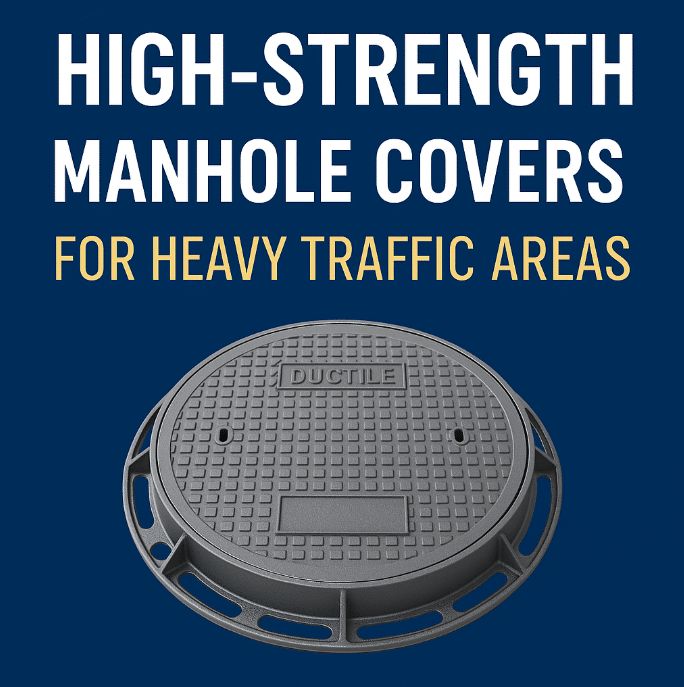Manhole covers in heavy traffic zones must endure extreme loads and repeated dynamic pressure. Choosing the wrong cover can lead to early failure, costly maintenance, and even road hazards. Therefore, infrastructure planners, civil engineers, and contractors must follow rigorous standards when selecting manhole covers for such environments.
1. Understand the Importance of Load Class Ratings
One of the most essential steps in selecting a manhole cover is identifying the correct load class, as specified in EN 124:2015 or equivalent international standards. Load ratings classify covers based on their ability to bear pressure.
- D400 Class – Suitable for roads carrying heavy vehicles, such as city streets and highways.
- E600 Class – Designed for areas with extremely high loads like loading docks and transport terminals.
- F900 Class – Built for the most demanding locations including airports, seaports, and industrial zones.
Recommendation: Always select a load class that exceeds the maximum expected traffic pressure to account for unforeseen stress and long-term fatigue.
2. Select Appropriate Materials for Maximum Durability
Material selection directly impacts a manhole cover’s strength, weight, corrosion resistance, and longevity.
● Ductile Iron (GJS500-7 or GJS600-9)
Ductile iron is the most preferred material for high-strength covers due to its:
- Superior tensile strength and elasticity
- Long fatigue life under repetitive stress
- Resistance to impact and deformation
● Composite Materials
Fiber-reinforced polymer composites offer corrosion resistance and light weight. However, they are not ideal for extremely heavy traffic unless reinforced with steel or designed specifically for such loads.
Tip: In critical areas, opt for ductile iron with an epoxy coating to enhance both load-bearing capacity and anti-corrosion performance.
3. Evaluate Surface Design and Safety Features
Manhole covers should offer more than just load resistance. Proper surface and frame design contribute to both user safety and operational efficiency.
- Anti-slip Surface Patterns: Essential to prevent skidding, especially in wet weather.
- Noise-Reducing Seals: Reduce vibrations and noise under traffic.
- Locking Mechanisms: Prevent theft and unauthorized access in high-risk zones.
- Self-Centering Features: Help maintain alignment between the cover and frame, reducing edge wear and road surface damage.
4. Ensure Compliance with Standards and Certifications
Reliable manhole covers must meet or exceed local and international standards such as:
- EN 124 (Europe)
- ASTM A536 (USA)
- ISO 1083 (Global)
- BSI Kitemark for added quality assurance
Choosing certified products guarantees that the manufacturer has conducted rigorous testing, including impact resistance, deformation, and fatigue analysis.
5. Factor in Installation and Maintenance Efficiency
Installation convenience and lifecycle cost are often overlooked. However, they significantly impact project timelines and long-term costs.
- Modular designs speed up installation
- Lifting handles or hinge systems reduce worker fatigue
- Corrosion-resistant coatings lower future replacement costs
Insight: Investing in a premium product upfront reduces overall maintenance and replacement frequency, especially in high-traffic areas.
Conclusion
Selecting high-strength manhole covers for heavy traffic areas demands careful evaluation of load ratings, materials, safety features, and certification standards. By adhering to engineering best practices and industry guidelines, infrastructure planners can significantly improve roadway safety, reduce downtime, and extend the service life of underground access systems.
Using reputable products from trusted manufacturers ensures both cost-efficiency and reliability. A well-chosen manhole cover is a critical investment in the overall performance of public infrastructure.
FAQ
Q1: What is the most suitable material for manhole covers in heavy traffic areas?
A1: Ductile iron is the most recommended material due to its exceptional strength, fatigue resistance, and durability.
Q2: Can composite manhole covers be used in highways or ports?
A2: Only if they are specifically engineered and certified for high load classes like E600 or F900. Otherwise, ductile iron is safer and more reliable.
Q3: How often should manhole covers be replaced?
A3: High-quality covers can last 10–20 years or more, depending on traffic load, environmental conditions, and maintenance frequency.
Q4: Where can I buy reliable and affordable high-strength manhole covers?
A4: You can source certified and competitively priced covers from Xinghua Casting, known for high quality, compliance with EN standards, and budget-friendly pricing for bulk infrastructure projects.





